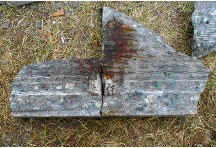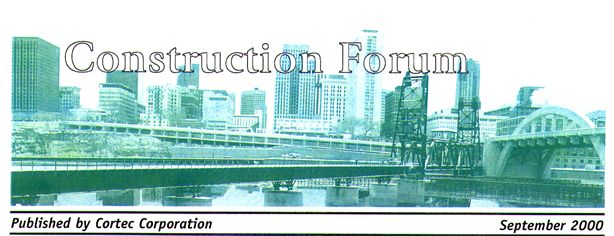Bridge
Collapses - Many Hurt
Epoxy-Coated
Rebars not Effective in Prestressed Concrete
 In
May of this year the future of a pedestrian bridge was reported
in ENR. It occurred at the Lowe's Motor Speedway in Charlotte, NC.
Over 100 fans were injured, some critically. Forensic engineers
investigating the accident found that the steel strands at the mid-point
of one prestressed concrete double tee had rusted completely through,
which caused it to snap under approximately one-sixth of its design
load. In
May of this year the future of a pedestrian bridge was reported
in ENR. It occurred at the Lowe's Motor Speedway in Charlotte, NC.
Over 100 fans were injured, some critically. Forensic engineers
investigating the accident found that the steel strands at the mid-point
of one prestressed concrete double tee had rusted completely through,
which caused it to snap under approximately one-sixth of its design
load.
Epoxy-coated
strands cannot be used in prestressed concrete. The use of a corrosion
inhibitor would have prevented this accident. For safety, corrosion
inhibitors should be used in all prestressed concrete that will
be exposed to the elements.
When the Allegan
Street Parking Ramp and Plaza in Lansing MI had to be restored,
a corrosion inhibitor was used with high quality concrete. The designers
felt that using epoxy-coated reinforcing steel in a non-prestressed
condition would likely result in significantly wider slab cracking.
This was reported in the Concrete Repair Bulletin, March/April,
2000.
 In
February 2000, the results of field tests on bridge decks in Virginia
were reported in Concrete International. In the 1970s short term
laboratory tests showed that epoxy-coated rebars could prevent corrosion
of steel in concrete. However, in 1988 through 1993 serious corrosion
problems were found with five major bridge structures in Florida
after a short service life (5 to 7 years for the Long Key Bridge).
Because of these findings, bridges and piers were studied in Virginia.
It was found that epoxy coatings loose their bond to steel in concrete
bridge decks in less than 15 years and in less than 8 years in concrete
piles. It is highly probable that the debonding takes place before
the salt reaches the rebars. If the epoxy to steel bond is significantly
reduced or the epoxy is not bonded to the steel, the epoxy-coated
rebar will provide the least, or possibly no additional, corrosion
protection service life extension. In
February 2000, the results of field tests on bridge decks in Virginia
were reported in Concrete International. In the 1970s short term
laboratory tests showed that epoxy-coated rebars could prevent corrosion
of steel in concrete. However, in 1988 through 1993 serious corrosion
problems were found with five major bridge structures in Florida
after a short service life (5 to 7 years for the Long Key Bridge).
Because of these findings, bridges and piers were studied in Virginia.
It was found that epoxy coatings loose their bond to steel in concrete
bridge decks in less than 15 years and in less than 8 years in concrete
piles. It is highly probable that the debonding takes place before
the salt reaches the rebars. If the epoxy to steel bond is significantly
reduced or the epoxy is not bonded to the steel, the epoxy-coated
rebar will provide the least, or possibly no additional, corrosion
protection service life extension.
The authors
stated that past and present epoxy-coated rebar prescription-based
specifications do not address the condition of the reduction in
epoxy bond to steel in moist concrete environments nor the corrosion
protection efficiency of epoxy-coated rebars with debonded coatings.
Hasan and Ramirez
studied the effects of static and repeated loadings on concrete
bridge decks and slabs reinforced with epoxy-coated bars. Their
work was reported in the Transportation Research Circular, No. 403,
March 1993 on page 46. Their findings indicate the average concrete
crack width is larger in specimens with epoxy-coated reinforcement
than in companion specimens with uncoated reinforcement.
|



